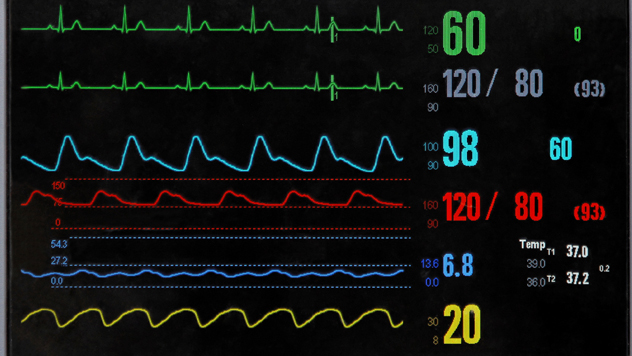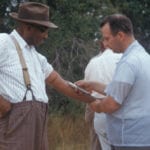 Movies and TV
Movies and TV  Movies and TV
Movies and TV  History
History 10 Things You Didn’t Know About the American National Anthem
 Technology
Technology Top 10 Everyday Tech Buzzwords That Hide a Darker Past
 Humans
Humans 10 Everyday Human Behaviors That Are Actually Survival Instincts
 Animals
Animals 10 Animals That Humiliated and Harmed Historical Leaders
 History
History 10 Most Influential Protests in Modern History
 Creepy
Creepy 10 More Representations of Death from Myth, Legend, and Folktale
 Technology
Technology 10 Scientific Breakthroughs of 2025 That’ll Change Everything
 Our World
Our World 10 Ways Icelandic Culture Makes Other Countries Look Boring
 Misconceptions
Misconceptions 10 Common Misconceptions About the Victorian Era
 Movies and TV
Movies and TV The 10 Coolest Stars to Set Sail on The Love Boat
 History
History 10 Things You Didn’t Know About the American National Anthem
 Technology
Technology Top 10 Everyday Tech Buzzwords That Hide a Darker Past
Who's Behind Listverse?

Jamie Frater
Head Editor
Jamie founded Listverse due to an insatiable desire to share fascinating, obscure, and bizarre facts. He has been a guest speaker on numerous national radio and television stations and is a five time published author.
More About Us Humans
Humans 10 Everyday Human Behaviors That Are Actually Survival Instincts
 Animals
Animals 10 Animals That Humiliated and Harmed Historical Leaders
 History
History 10 Most Influential Protests in Modern History
 Creepy
Creepy 10 More Representations of Death from Myth, Legend, and Folktale
 Technology
Technology 10 Scientific Breakthroughs of 2025 That’ll Change Everything
 Our World
Our World 10 Ways Icelandic Culture Makes Other Countries Look Boring
 Misconceptions
Misconceptions 10 Common Misconceptions About the Victorian Era
10 Mind-Bending Sci-Fi Advancements In Brain Science
Most people don’t think about neuroscience on a daily basis. Neuroscientists’ work is usually obscure, tedious research that incrementally improves our understanding of the brain and our nervous system.
Yet, occasionally, their experiments result in findings that otherwise only appear in science fiction novels. Here are some of the more surprising ones.
10Creating Artificial Memories
Is it possible to artificially create an entirely fake memory that is virtually indistinguishable from a real one? Yes, it is—if you’re one of the researcher at UC Irvine.
In a study on rats, these researchers managed to introduce new, targeted memories into the rodents’ brains. They played a specific tone to which they wanted the rats to respond, while simultaneously releasing acetylcholine—a chemical responsible for the formation of new memories.
The result? Rats developed the expected response to that particular tone, when tested the day after the experiment. These new memories had “the same features” as their naturally-occurring counterparts. Furthermore, the artificial memories were retained in the long run, proving that it is possible to permanently shape memories under lab conditions.
The researchers hope that these findings pave way for helping people with memory and learning disabilities, potentially by introducing new memories using similar accelerated techniques. We’re probably still some way from a future where we acquire new knowledge on demand, like the protagonists in The Matrix—but one can always dream.
Oh, and speaking of dreams . . .
9Manipulating Dreams

If there’s one thing we know about dreams, it’s that they’re unique for each individual. They’re a product of your recent experiences, emotions, and thoughts. You can’t simply make someone dream whatever you want.
Or can you?
Scientists at MIT managed to do just that. They started by training rats to run a maze. The rats were given two distinct audio cues to help them navigate the maze and find treats. One tone would tell the rats that the treat was to their left; the other tone told them to turn right. Rats love treats, so very soon they learned what the two different tones meant, and responded to them accordingly when navigating the maze. Researchers then recorded the specific changes in the rats’ brain waves as they responded to the two different tones.
Finally, it was time to mess with the rats’ dreams. When the rats went to sleep, their brain activity was monitored to establish that, yes—they were dreaming about running through the maze. At that point, the researchers tried influencing the dreams by playing the two different tones.
Curiously, the brain scans showed that the rats, while dreaming, responded to the audio cues in exactly the same way as they did when awake. This experiment proves that dreams can be directly shaped by external triggers. The researchers even speculate that one day it will be possible for people to have customized dreams via such “dream engineering.”
8Recording Dreams
What if you wanted to record your dreams, so that you could watch them later, like a movie? It turns out that, eventually, this may very well be possible. A study by researchers in Kyoto, Japan showed that brain scans can be used to create a representation of people’s dreams, in real-time.
The first stage of their study had people sleeping inside an MRI scanner while their brain activity was recorded. They were then woken and interviewed about what they had seen while dreaming. This was done around 200 times for each of the three study participants.
During the second stage, researchers isolated the 20 most commonly seen objects, and found photos representing these. They showed these objects to the participants, while measuring their brains’ responses to them to establish a correlation. Afterwards, the researchers fed the photos and the corresponding MRI scans into a learning algorithm.
Finally, the three participants were invited to sleep inside the MRI scanner once again. Meanwhile, the smart algorithm generated strings of images, based on the sleepers’ brain activity. The subjects were then woken and asked about their dreams. In the end, the algorithm was able to match the dreams with about 60 percent accuracy.
While far from perfect, this is a first step toward being able to truly record dreams. We already know that it’s possible to create crude, but surprisingly advanced movies that represent our brain’s activity. In light of this Japanese dream study, it may only be a matter of time before we can do the same with our dreams.
7Brain Cell Transplants
Can brain transplants be used to enhance brain function? To answer that question, scientists at the University of Rochester Medical Center created human chimeric mice. That sounds ominous, but it simply meant that these mice were given human astrocytes—a particular type of brain cells. The mice were injected with 100,000 of these astrocytes while they were still developing.
Remarkably, by the time the mice turned six months old, these human cells had essentially fully replaced the equivalent mice brain cells. The researchers then subjected the mice to numerous tests, designed to evaluate their memory and learning abilities. These “smart” mice ended up performing markedly better across a wide range of tests than the control group, and were generally shown to be quicker at learning.
Neuroscientist Bruce Ransom acknowledged the significance of this research, saying: “It’s a stunning result. It provides the first unequivocal evidence that astrocytes may well have been one of the evolutionary drivers of human capabilities.” Curiously, that quote is suspiciously devoid of commentary on the dangers of breeding hyper-intelligent rodents.
6Improving Vigilance
We’ve all been in situations that required prolonged focus—think final exams, filing tax returns, and Lord of the Rings marathons. We can all attest to eventually getting tired and losing our ability to pay attention. What if there was a way to make us more alert during these types of activities?
There is, and all it requires is zapping your brain with a controlled electrical current. A study subjected participants to a number of alertness tests. Some participants received noninvasive brain stimulation, in the form of “prefrontal transcranial direct current stimulation” (tDCS). Others received a sham treatment. In the end, people receiving tDCS were more focused and sustained their level of alertness over longer periods of time.
The study proves that targeted stimulation can be effectively applied to make better use of the brain’s often untapped resources; people can be made more vigilant. Researchers suggest that this method is suitable for counter-balancing decrease in performance of workers that require long periods of sustained attention.
5Making Us Better Liars


Not all tDCS is used for good. Some applications of noninvasive brain stimulation can be directed toward a less ethical pursuit: helping us lie more convincingly.
A study instructed 44 volunteers to role-play as thieves. Participants had to pretend to steal money and were then interrogated about their misdeeds. This interrogation was conducted via the “Guilty Knowledge Test,” a variation of the polygraph test.
By using tDCS to inhibit the function of the anterior prefrontal cortex—the part of the brain responsible for deception—scientists were able to trigger remarkable improvements in test subjects’ ability to lie. People receiving brain stimulation were quicker at coming up with lies, though no quicker when answering truthfully. Perhaps even more interestingly, these participants were also shown to feel less guilty about lying than the control group.
This indicates that it may be possible to improve somebody’s ability to lie at will, should that be required. Think of the many professionals that could benefit from this type of improved lying ability: spies, undercover cops, soldiers taken prisoner, and campaigning politicians.
4Brain-Boosting Music

It’s pretty well known that music has a measurable effect on our mood and our perception of the world. You can probably easily recall a time when a particularly sad song made you melancholy, or, conversely, an upbeat track that made you want to smile and dance.
Turns out it’s not only our emotions that can benefit from a dose of good music. Our cognitive abilities can also be affected by listening to specific musical scores. Research by Northumbria University in UK had people performing a test that measured mental concentration. Participants had to watch for a green square to pop up on a computer screen, and press space as it did so, while ignoring other colors and shapes.
Some participants did so in silence; others listened to different movements from Vivaldi’s The Four Seasons concerti. The more upbeat “Spring” concerto resulted in the best average response time of 393.8 milliseconds; the slow “Autumn” one increased people’s reaction time to 413.3 milliseconds, as compared to the 408.1 milliseconds for those who listened to no music at all.
Another study showed that music can help people recall autobiographical memories following an “acquired brain injury.” So it seems that carefully chosen music can play a pivotal role in boosting people’s cognitive abilities, attention, and memory.
3Prosthetic Brain

By now, science has advanced far enough to find ways of replacing most parts of our body. We have prosthetic arms, prosthetic legs, and appear to be on the verge of making functioning prosthetic eyes. However, the brain is a lot more complex than a limb. Making a brain prosthesis is far from a straightforward task, and we are a long way from making fully-functional brain replacements. Nevertheless, we are taking significant leaps forward on that front, with a so-called “neural prosthesis” that has been shown to restore brain function after traumatic head injury.
In a proof-of-concept study, scientists cut off communication between areas of a rat’s brain, simulating a traumatic brain injury. The study’s 16 rats lost almost all function in their forelimbs. Some were left untreated; others were given a device that randomly stimulated different areas of the brain. A third group of rats were fitted with the neural prosthesis, which created a bridge between the two disconnected areas of the brain.
Results were convincing. After two weeks, the neural prosthesis group regained brain function to such an extent that “their movements were indistinguishable from their behavior before their brain injury.” The implanted brain-machine-brain interface basically allowed for the two disconnected areas of the brain to properly communicate with each other once again. Researchers hope that this study leads to the creation of a similar prosthesis to treat brain injury and stroke trauma in humans. Combined, these types of injuries—in US alone—affect almost three million people.
2Hacking Brains To Access Sensitive Data

Everyone knows that our digital devices are prone to hacker attacks. Tech-savvy people can access your credit card information and PIN codes with relative ease, especially if most of your passwords are literally “password.” The best way to keep sensitive data private is to store it safely in the unhackable fortress that is your brain. That way, nobody could possibly gain access to the information, right?
Not quite. At the USENIX Security Conference 2012, researchers have demonstrated how information can be made easier to extract using simple, off-the-shelf devices. For their demonstration, they used a relatively inexpensive, readily available brain–computer interface (BCI) and their own mind-reading program. Participants were analyzed without being explicitly told that their brain would be “hacked” in the process.
By reading the electroencephalography (EEG) signals produced by the subjects’ brains, researchers were able to prove that access to private information—PIN codes, credit card data, and so on—can be made measurably easier via consumer-grade BCI devices. While not making such information fully transparent, “the entropy of the private information is decreased on the average by approximately 15 to 40 percent compared to random guessing attacks,” when using BCI.
1Mind Control

As curious as the above studies are, perhaps none of them come as close to the realm of science fiction as mind control—one of the most explored “what ifs” in many movies and books. While true mind control isn’t exactly on the horizon, a few recent studies have yielded some pretty extraordinary results.
In a Harvard Medical School study, humans were able to directly control movements of a rat’s tail using thoughts alone. Human subjects were fitted with a BCI device that converted their thoughts into computer commands. The rats, in turn, were outfitted with a computer-to-brain interface that used focused ultrasound to stimulate their brains.
As a result, a brain-to-brain connection opened between the humans and the rats, allowing humans to remotely control the rats’ tails at will. The study had an astonishing 94 percent success rate, across six different humans and six different rats. Notably, the established brain-to-brain connection was entirely noninvasive, requiring no complex surgical procedures.
If you think that’s impressive, wait until we tell you about a recent study at the University of Washington. This study used similar brain-to-brain communication, with one noteworthy difference: Both subjects were human.
Two researchers were located in different parts of the university’s campus. One wore a cap that converted his thoughts into electrical signals, while his colleague wore one that allowed his brain to receive magnetic signals. The first researcher had to play a computer game that had him firing a cannon at different targets. The catch? He had to do so without using his hands. Instead, he had to imagine firing the cannon in his mind, thereby making his colleague do the actual key-pressing at the right moment.
The study was a success. While researchers are quick to highlight that this experiment is quite basic in its setup, they believe it is a first cautious step toward more elaborate applications. Some years down the line we may see numerous social uses for such direct mind control. These may include everything from letting people with disabilities communicate better, to remotely helping somebody land an aircraft.
For now, that’s speculation. Yet one thing is certain: Neuroscience is an increasingly exciting research area that surely has more futuristic developments in store for us.
Daniel edits words for Listverse, writes words for Cracked, and does other stuff on his blog.








